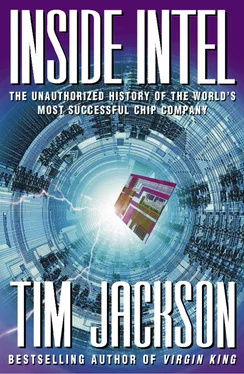Graham made an important contribution to the new company right away. Over a series of phone conversations with Noyce and Moore, he pressed the case for building bipolar circuits as well as those based on metal oxide on silicon technology. His reasoning was straightforward. Memory circuits based on MOS would still require peripheral devices, known as ‘drivers’, to allow them to work properly with the computer. Those drivers would have to be bipolar. If Intel did not develop its own bipolar processes, it would be forced to rely on other companies to build them – yet the bipolar companies, terrified that MOS would put them out of business, would have no incentive to cooperate with Intel. Even if MOS were a sure bet – which it wasn’t yet, not by any means – Graham was convinced that Intel needed a bipolar division too to ensure its survival.
Bob Graham’s contract in Florida required him to give ninety days’ notice, so Andy Grove was already on board when Graham reappeared in California ready to do business. This had two significant effects on Graham’s career with Intel. One was that he had no hand in hiring many of the first wave of staff people; instead, it was with Grove that dozens of engineers and managers made their first contact, and to him that they established their first loyalty. The other effect of Graham’s delayed arrival was that Grove took on more responsibility than he otherwise might have done. Who does what is always vague in a startup; an intelligent, energetic person with an eye for detail who is willing to do the things that others have left behind can become considerably more powerful than his job title would suggest. And Andy Grove was the ultimate details guy.
4
Into the Potato Patch
SOME TIME IN THE FALL of 1968, when Intel’s research into semiconductor memory was already in full flow, one of the company’s first hires grabbed Bob Noyce in a corridor. ‘Bob,’ he said, ‘there’s something I need to ask you. I’ve been here for three days already, and I’m not really clear on the reporting structure of this outfit. Can you just draw me a quick organization chart?’
Noyce smiled, and turned into an open doorway. Walking to the blackboard, he picked up a piece of chalk and drew a small X. Around it, he swept a circle, and along the circle he added six or seven more Xs. Then he drew a spoke connecting each of the Xs outside the circle to the X in the centre.
He pointed to the X in the centre. ‘That’s you,’ he said. ‘And these’ – he tapped the outside Xs one by one, the clack of the chalk echoing against the linoleum floor – ‘these are me, Gordon, Andy, Les, Bob, Gene, and the other people you’ll be dealing with. That’s what our organization chart looks like.’
Noyce’s point was more than mere rhetoric. At Fairchild Semiconductor, the East Coast owners of the business had been very strong on hierarchies and on reporting. They believed in ‘clear lines of command’. They thought employees should be like officers in an army, communicating only with their immediate superiors and immediate inferiors. And like soldiers, they considered it the height of disloyalty for an employee to raise an issue with someone higher up if he was dissatisfied with the response he had been given by his immediate superior.
Visionaries before their time, Noyce and Moore saw that in a fast-moving industry where speed of response to change was all-important, and where information had to flow as swiftly as possible if the company was to make the right decision, this approach did not make sense. Instead, they wanted to encourage anyone who had a good idea to speak up, anyone who had a question to ask it. Staff meetings were to be open to anyone who thought they could contribute something by attending; no manager, no matter how senior, should refuse a request for help or information from another employee.
The prestige of Intel’s stars was never in doubt – the PA system kept drumming it in, day after day, as announcements went out every few minutes for Doctor Noyce, Doctor Moore, Doctor Grove. But they were very visible, mucking in where needed. If a circuit layout needed to be checked, Bob Noyce would be ready to lend a hand. If a process designer needed to know something about the behaviour of transistors under specific temperature ranges, Andy Grove would be ready to pull down from the shelf the textbook he had written on semiconductor physics, identify the key equations that predicted how a substance would behave, and help to turn the equations into statements in the FORTRAN programming language. If a piece of complex machinery didn’t work, the man who unscrewed the casing and took a look inside might well be Gordon Moore.
Inevitably, this led to some tensions within a matter of months. Gene Flath, who had been hired to run the company’s first fabrication line, began to find that engineers he had asked to go off and deal with a process problem would come back and announce that they had done something completely different. When he asked them why, the answer would always be the same: ‘Grove told me to do it’. When Flath confronted Grove – and confrontations inside Intel would often be with both parties screaming at the top of their lungs, in front of other people – Grove would deny that he’d given the errant engineers any direct orders. It took some time for Flath to convey to Grove that, as director of operations, he had more power than he realized. To the average engineer, a ‘suggestion’ from Grove was something to be acted on immediately. If Flath was expected to deliver on commitments he had made, this would have to stop. The philosophy inside the company that anyone could talk to anyone else was fine, Flath believed – but it had its drawbacks: ‘It’s very desirable, because you get a lot of good ideas. But it’s not OK to change the batting order without anybody decreeing that this is what would happen’.
The company’s first year was punctuated by intermittent stand-up screaming matches while issues such as this one were gradually sorted out. But broadly, Intel people felt a refreshing sense of freedom. Instead of having to fight the bureaucracy of a purchasing department, every engineer had the authority to sign on behalf of the company for equipment costing up to $100,000. The company parking lot had no pre-assigned spaces for senior management; instead, the rule was simply that those who arrived earliest for work got the spaces closest to the front door. And as the research continued, there was a feeling that you were part of an elite corps, an assembly of the brightest, hardest-working people, a world-beating team. Of course there was a risk of failure. But everyone knew that a talented engineer could easily find work elsewhere if things didn’t work out. There was no fear of long-term unemployment to discourage risk-taking.
‘They offered me the job at the end of breakfast,’ said one of Intel’s very first engineering hires. ‘I called my wife, and told her that I’d just accepted a job with a pay cut of one-third, working for an unknown startup. The good news, I said, was that there were some big names running it. And if it proved a mistake, I could always go and pump gas some place.’
Of the three memory technologies that Moore wanted to investigate, one swiftly ruled itself out. An early look at multichip memory modules suggested that it was too far from becoming a commercial product to be worth devoting effort to. That left the bipolar route and the MOS route. By the fall, Intel’s engineering effort was clearly organized into two terms, each led by a former Fairchild research engineer, to follow these up separately. The MOS team was led by Les Vadasz, a balding, short-tempered engineer who shared Andy Grove’s Hungarian background; the bipolar team came under the control of a brilliant but equally short-tempered engineer called Dick Bohn.
Читать дальше








![Chade-Meng Tan - Search Inside Yourself - Increase Productivity, Creativity and Happiness [ePub edition]](/books/703803/chade-thumb.webp)
